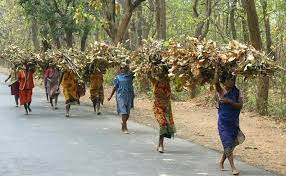Why in NEWS ?
Recently, the Environment Ministry and Ministry of Tribal Affairs jointly issued a communique to Chief Secretaries of States to review the implementation of the Forest Rights Act that came into force in 2006 and ensure better coordination among forest departments and forest communities.
About Forest Rights Act (FRA)
- A large number of people especially the scheduled tribes have lived in and around forests for a long period in symbiotic relationship.
- During the colonial time the focus shifted from the forests being used as a resource base for sustenance of local communities to a State resource for commercial interests and development of land for agriculture.
- Several Acts and policies such as the 3 Indian Forest Acts of 1865, 1894 and 1927 of Central Govt and some state forest Acts curtailed centuries‐old, customary‐use rights of local communities.
- This continued even after independence till much later until enactment of The Scheduled Tribes and Other Traditional Forest Dwellers (Recognition of Forest Rights) Act, 2006.
- The Forest Rights Act, India or the Scheduled Tribes and Other Traditional Forest Dwellers (Recognition of Forest Rights) Act is also known by other names like the Tribal Rights Act or the Tribal Land Act.
- It deals with the rights of forest-dwelling communities over land and other resources.
- The Act grants legal recognition to the rights of traditional forest dwelling communities, partially correcting the injustice caused by the forest laws.
Forest Rights Act (FRA) 2006
The below table mentions some key facts about the Forest Rights Act 2006:
| What is it called? | Scheduled Tribes and Other Traditional Forest Dwellers (Recognition of Forest Rights) Act (FRA) |
| What does the Act intend? | The act tries to recognize marginal and tribal communities’ rights over forest lands over which they were traditionally dependent |
| Are communities’ rights catered to by FRA 2006? | Yes, the act intends to help all the destitute forest communities across India to have right over common property forest lands |
| What is the potential of FRA 2006? | This Forest Rights Act is capable of:Empowering local self-governanceIssue of poverty alleviation and pro-poor growth is paid heed to Conservation and management of natural resources of India are highlighted and addressed by the FRA |
Key Terms related to the Forest Rights Act (FRA)
The table below mentions the key-terms in accordance with the Forest Rights Act 2006 (FRA):
| Term | Meaning |
| Community Forest Resource | It is a customary common forest land located in a villages’ traditional and customary boundariesIt can also be called seasonal use of landscape in the case of pastoral communities Example – Reserved Forests, Protected Forests, Protected Areas (Sanctuaries, National Parks) |
| Critically Wildlife Habitat | Government of India (Ministry of Environment & forest) notifies such areas as CWH which meets a scientific criteria decided by an expert committee including experts from locality appointed by the government and from that of the Ministry of Tribal Affairs. |
| Forest Dwelling Scheduled Tribes | Persons or group of persons who reside in and are dependent on a forest land to meet their livelihood needs |
| Forest Villages | Forest Department of State Governments established settlements inside forests for forestry operations. It includes:Forest Settlement VillagesFixed Demand HoldingsAll types of taungya settlementsLands for cultivation and uses permitted by the government |
| Minor Forest Produce (MFP) | An important source of livelihoods for tribal people are non-wood forest products, generally termed ‘Minor Forest Produce (MFP)’ means all non-timber forest produce of plant origin and will include bamboo, canes, fodder, leaves, gums, waxes, dyes, resins and many forms of food including nuts, wild fruits, Honey, Lac, etc. |
| Other Traditional Forest Dwellers | Member/community prior to 13th December 2005, who resided for at least three years or were dependent on a forest land for their livelihood needs |

Rights under the Act:
The Act recognizes and vest the forest rights and occupation in Forest land in Forest Dwelling Scheduled Tribes (FDST) and Other Traditional Forest Dwellers (OTFD) who have been residing in such forests for generations. The act identify four types of rights:
- Title rights – Ownership to land that is being farmed by tribals or forest dwellers subject to a maximum of 4 hectares; ownership is only for land that is actually being cultivated by the concerned family, meaning that no new lands are granted.
- Use rights – to minor forest produce (also including ownership), to grazing areas, to pastoralist routes, etc.
- Relief and development rights – to rehabilitation in case of illegal eviction or forced displacement; and to basic amenities, subject to restrictions for forest protection.
- Forest management rights – to protect forests and wildlife.
Who can claim these Rights?
- Members or community of the Scheduled Tribes who primarily reside in forests and who depend on the forests or forest lands for a livelihood.
- It can also be claimed by any member or community who has for at least three generations (75 years) prior to the 13th day of December, 2005 primarily resided in forests land for bona fide livelihood needs.
Process of recognition of rights:
- First, the gram sabha (full village assembly, NOT the gram panchayat) makes a recommendation – i.e who has been cultivating land for how long, which minor forest produce is collected, etc. The gram sabha plays this role because it is a public body where all people participate, and hence is fully democratic and transparent.
- The gram sabha’s recommendation goes through two stages of screening committees at the taluka and district levels.
- The district level committee makes the final decision . The Committees have six members – three government officers and three elected persons.
- At both the taluka and the district levels, any person who believes a claim is false can appeal to the Committees, and if they prove their case the right is denied .
- Finally, land recognised under this Act cannot be sold or transferred.
Importance
- The acts looks to right the wrongs of government policies in both colonial and independent India toward forest-dwelling communities, whose claims over their resources were taken away during 1850s.
- Community rights and rights over common property resources (CPR) have been recognized for the first time
- Individual rights of the tribal and marginal communities have been highlighted by this act along with other rights too
- The concept of revenue villages have surfaced as the act talks about the conversion of all forest villages, old habitation, un-surveyed villages and other villages into these.
- It ensures the livelihood and food security of the Forest Dwellers Scheduled Tribes and Other Forest Dwellers and strengthens the conservation regime of the forest.
- Community Forest Resources are monitored and managed in a way that protects marginal communities’ traditional linkages with these. it is known how these communities have always traditionally utilized the forest resource for sustainable development.
- This act in a way protects intellectual property rights and the traditional knowledge related to cultural diversity and biodiversity
- The act also has potential of sustainably protecting forest through traditional ways along with providing tribes means of livelihood.
- It expands the mandate of the Fifth and the Sixth Schedules of the Constitution that protect the claims of indigenous communities over tracts of land or forests they inhabit.
- The alienation of tribes was one of the factors behind the Naxal movement, which affects states like Chhattisgarh, Odisha and Jharkhand. The act through identifying IFR and CFR tries to provide inclusion to tribes.
- It has the potential to democratise forest governance by recognising community forest resource rights over an estimated 85.6 million acres, thereby empowering over 200 million forest dwellers in over 1,70,000 villages.
- The act will ensure that people get to manage their forest on their own which will regulate exploitation of forest resources by officials, forest governance and management as well as tribal rights etc.
Challenges
- Administrative Apathy
- Implementation of the act remains the biggest challenge as acts related to the environment are not entirely compliant with the law, illegal encroachments have happened as much as that claims have been unfairly rejected.
- As tribals are not a big vote bank in most states, governments find it convenient to subvert FRA or not bother about it at all in favour of monetary gains.
- Though the act tries to focus on the needs of the forest dwellers, it defeats the purpose when the eviction rate of families from these lands increases as their claims on these lands are not accepted by the government.
- Lack of Awareness
- Unawareness at the Lower level of forest officials who are supposed to help process forest rights claims is high and majority of the aggrieved population too remains in the dark regarding their rights.
- The forest bureaucracy has misinterpreted the FRA as an instrument to regularise encroachment instead of a welfare measure for tribals.
- Dilution of Act
- Certain sections of environmentalist raise the concern that FRA bend more in the favour of individual rights, giving lesser scope for community rights.
- Government’s role of allowing commercial plantations in degraded land is also debated and questioned as the degraded land makes 40% of forests.
- Reluctance of the forest bureaucracy to give up control
- There has been deliberate sabotage by the forest bureaucracy, both at the Centre and the states, and to some extent by big corporates.
- The forest bureaucracy fears that it will lose the enormous power over land and people that it currently enjoys, while the corporates fear they may lose the cheap access to valuable natural resources.
- Institutional Roadblock : Rough maps of community and individual claims are prepared by Gram Sabha which at times often lack technical knowhow and suffers from educational incapacity.
Conclusion
- The government of India views MFP rights as a means to curb Naxalism since the states most affected by Naxalism are also home to the maximum number of people dependent on forest produce.
- The recognition of CFR rights would shift forest governance in India towards a community conservation regime that is more food security and livelihood oriented.
- Large-scale awareness and information dissemination campaigns are required at local level informing both tribal and lower level officials.
- It is important to develop a detailed strategy of training and capacity building of people responsible for implementing the FRA, such as Panchayats, Gram Sabha, village level Forest Rights committee etc.
- The relevant maps and documents should be made available to the Forest rights committee and claimants to simplify the task of the Gram Sabha in identifying and filing claims for individual and community rights.
- Providing clarity on the time limit for settling claims the act does not specify any time limit for resolving claims. In most of the areas, both the officials and beneficiaries are unaware of this fact.
- Centre should take more proactive role in pushing states to honour a law that could change the lives of millions.
Also refer :








